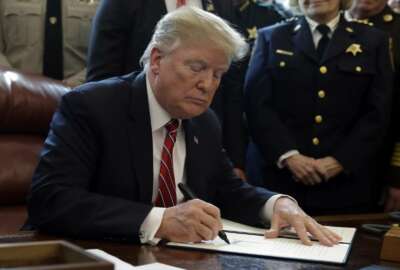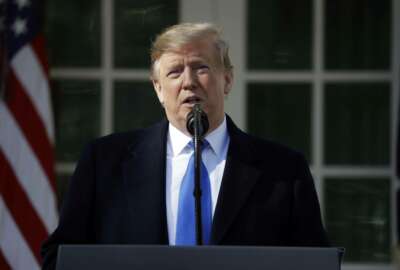
The 2019 federal pay raise is official, so now what?
The President made the retroactive federal pay raise official with an executive order on Thursday. But agencies have more work to do to finalize the pay bump for...
This story was update on Monday, April 1 at 5:15 p.m. to reflect a statement from the Office of Personnel Management.
The Trump administration said last week it was the complexity of the federal pay system that prevented it from implementing a retroactive raise to employees more quickly.
But now that the retroactive raise is official, federal employees expecting the pay bump to appear overnight may be in for a rude awakening.
The timing of pay raise implementation, however, may ultimately depend on the complexity of an employee’s situation.
“The timing of when federal employees will see a raise in their paycheck will vary,” a spokesman said Monday in a statement to Federal News Network. “Agencies and payroll providers are currently working quickly to update their systems and process retroactive pay actions now that OPM has issued the new pay tables. Employees are encouraged to consult their human resource office or payroll providers for further information.”
As OPM described in a series of memos released Thursday night, agencies and their payroll providers may need to account for an employee’s separation, transfer to another agency, retirement, award or any number of other circumstances that may make these pay adjustments more complicated.
Here’s what you need to know.
Retroactive pay for employees who left or transferred
With the President’s executive order, most federal employees will receive, on average, a 1.9 percent federal pay raise. The increase is retroactive to the first pay period in 2019, which was Jan. 6 for most employees. It consists of a raise of 1.4 percent, with an additional 0.5 percent adjusted in locality pay rates.
Though the executive order and new pay rates from OPM are a key step in finalizing the 2019 federal pay raise, agencies have more to do to ensure federal employees are completely squared away.
Pay for employees who left government on or after Jan. 6, for example, needs to be adjusted to reflect the 1.9 percent raise. Agencies should make sure these employees receive additional pay for whatever time they worked between Jan. 6 and their separation date, according to OPM.
The same applies to employees who may have transferred to another agency on or after Jan. 6. An employee’s prior agency is responsible for adjusting and processing additional pay owed because of the retroactive raise, OPM said. These adjustments should cover the time between Jan. 6 and the date an employee left the prior agency and started working for another.
In addition, agencies will also need to review any awards, allowances or other incentives they distributed between Jan. 6 and the date that the employees’ retroactive pay adjustment is finalized.
Retroactive pay for recent retirees
Agencies may need to adjust lump sum payments for annual leave for the employees who separated or retired in late 2018 or early 2019, according to OPM.
“The lump-sum payment for annual leave must be calculated on the basis of the amount of pay the employee would have received if he or she had remained in federal service and used the annual leave,” Weichert wrote in one of the memos. “The retroactive adjustment also may affect severance payments computed using the pay rates in effect before the retroactive adjustment.”
In addition, federal payroll providers must adjust employee deductions and government contributions, because the 2019 retroactive pay adjustment is considered “basic pay” for retirement purposes.
Payroll providers should submit those adjustments to OPM, according to the agency. Providers must also submit a “supplemental individual retirement record” for employees who retired after the Jan. 6, which will indicate the retiree’s revised salary rate and employee deductions, OPM said.
Pay raises for SES, political appointees
Non-career members of the Senior Executive Service will receive a 1.4 percent general pay raise.
Employees on the Executive Schedule will also see a 1.4 percent raise. Pay tables for Executive Schedule rates can be found here.
Members of the SES, individuals on the Executive Schedule, employees under the senior level, scientific and professional pay systems, employees paid under critical pay authority and prevailing rate employees generally do not receive locality pay adjustments.
The pay situation for certain senior political officials is also complex, to say the least.
Congress has frozen pay for political appointees at least since 2014, when lawmakers included a provision holding pay rates at 2013 levels in a 2014 omnibus. The provision detailing the pay freeze has become practically standard appropriations language since then, and it has appeared in subsequent spending bills and continuing resolutions for the past four years.
Though the 2019 spending bill that President Donald Trump signed back in February continued a pay freeze for senior political officials and the vice president in 2019, it does allow for an increase of up to 1.9 percent of preexisting rates.
This situation will continue through the last pay period in 2019, unless Congress says otherwise in new legislation for the following year.
Specifically, this covers employees serving in an Executive Schedule position, a political appointment and a chief of mission or ambassador at large. It also covers non-career appointees in the Senior Executive Service paid at or above a specific Executive Schedule rate of $164,200 in 2018, as well as limited term appointees or certain limited emergency appointees in the SES.
Pay for freeze-covered Executive Schedule employees and those paid at an EX rate by law will range from $148,500-to-$203,500, according to OPM guidance on the matter.
The Vice President will receive $235,100.
About those six new locality pay areas…
Several federal employees in recent days have expressed disappointment with the locality pay adjustments for the six new areas OPM finalized back in December.
The administration had added Birmingham, Alabama; Burlington, Vermont; Corpus Christi, Texas; Omaha, Nebraska; San Antonio, Texas; and Virginia Beach/Norfolk, Virginia, as separate locality pay areas.
Now, employees in these six new locality pay areas will see the following locality payments, as opposed to the 15.37 percent they received under their previous “rest of U.S.” designation last year.
If employees in these areas hadn’t gotten their own locality pay designation this year, they would have seen a 15.67 percent adjustment, the “Rest of U.S.” rate for 2019. For employees in San Antonio, their new locality rate is less than half a percentage point from the “Rest of U.S. rate in 2019. For Birmingham, employees there will get locality boost that’s 0.1 percent higher than the rest of the country.
According to OPM, locality pay adjustments become less lucrative the more distinct areas there are.
“When locality pay percentages are adjusted, the practice has been to allocate a percent of the total GS payroll for locality pay raises and to have the overall cost for such pay raises be the same, regardless of the number of locality pay areas,” OPM wrote in December in the final rule announcing the addition of the six new areas.
Copyright © 2024 Federal News Network. All rights reserved. This website is not intended for users located within the European Economic Area.
Nicole Ogrysko is a reporter for Federal News Network focusing on the federal workforce and federal pay and benefits.
Follow @nogryskoWFED






